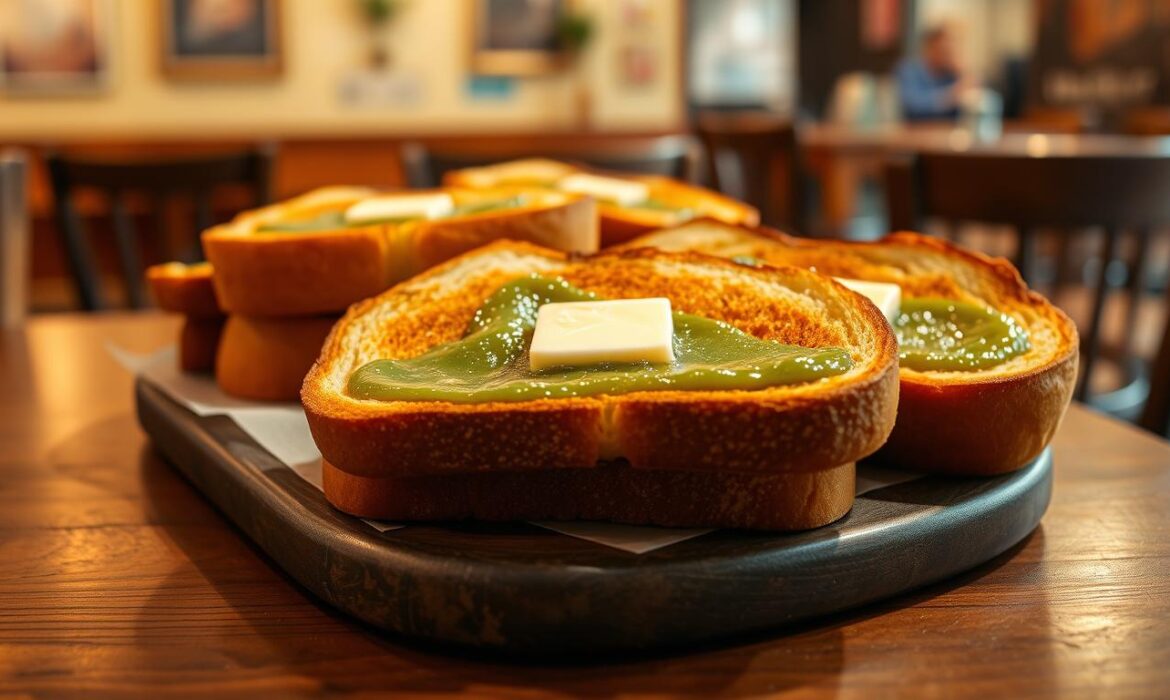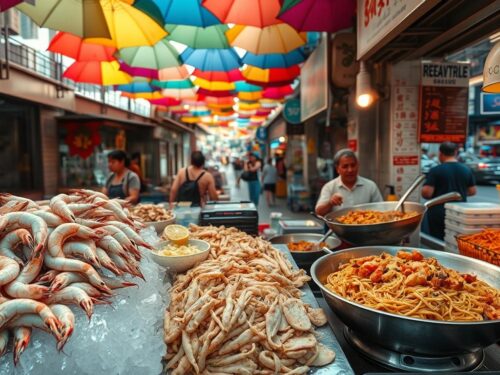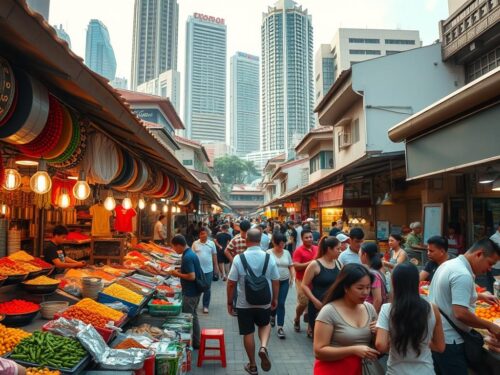Singapore’s breakfast culture is incomplete without the iconic kaya toast. This creamy, fragrant spread made from coconut, eggs, and pandan has become a symbol of the city’s rich culinary heritage. Whether paired with soft-boiled eggs or a cup of kopi, it’s a morning ritual for many locals and visitors alike.
From traditional kopitiams to modern artisanal creations, the options for enjoying this beloved food are endless. This guide explores the top-rated brands and eateries, each offering unique twists like charcoal-grilled toast or innovative flavor combinations. Whether you’re a fan of the classic Hainanese style or the vibrant Nyonya version, there’s something for everyone.
Our selection is based on rigorous taste tests, focusing on sweetness balance, texture quality, fragrance authenticity, and value. Get ready to discover the ultimate spots to savor the best kaya in town.
Key Takeaways
- Singapore’s kaya toast is a breakfast staple with deep cultural roots.
- Explore both traditional kopitiams and modern artisanal options.
- Unique variations include charcoal-grilled toast and innovative flavors.
- Top-rated brands are evaluated for sweetness, texture, fragrance, and value.
- Discover the best spots to enjoy this iconic spread.
Introduction to Kaya: A Singaporean Breakfast Staple
Kaya toast has become a beloved part of Singapore’s breakfast culture. This creamy, fragrant spread made from coconut, eggs, and pandan is more than just food—it’s a cultural experience. Whether enjoyed at a bustling coffee shop or a modern café, it’s a morning ritual that brings people together.
What is Kaya?
Kaya is a sweet, custard-like spread made from coconut milk, eggs, sugar, and pandan leaves. Its smooth texture and rich flavor make it a perfect pairing for toasted bread. The pandan leaves give it a unique aroma, while the coconut adds a creamy richness.
The History of Kaya in Singapore
The origins of kaya can be traced back to the early 20th century, when Hainanese immigrants brought their culinary traditions to Singapore. One of the earliest known places to serve it was Kheng Hoe Heng Coffeeshop, established in 1919. This laid the foundation for what would become a national favorite.
In 1944, Ya Kun Kaya Toast opened its doors, introducing charcoal-grilled toast and a secret recipe that’s still used today. With over 80 years of history, Ya Kun has become synonymous with traditional kaya toast. Later, in 1991, Killiney Kopitiam modernized the tradition, offering a fresh take on this classic dish.
“Kaya toast is more than just breakfast—it’s a taste of Singapore’s heritage.”
Over the years, kaya has evolved from a kopitiam staple to a gourmet delight. Today, it’s enjoyed in various forms, from classic Hainanese recipes to innovative modern twists. Its iconic pairings—soft-boiled eggs and a cup of kopi or teh—remain unchanged, offering a comforting start to the day.
| Milestone | Year | Significance |
|---|---|---|
| Kheng Hoe Heng Coffeeshop | 1919 | One of the earliest known places to serve kaya. |
| Ya Kun Kaya Toast | 1944 | Introduced charcoal-grilled toast and a secret recipe. |
| Killiney Kopitiam | 1991 | Modernized the tradition with a fresh approach. |
What Makes the Best Kaya in Singapore?
A great kaya spread is defined by its balance of flavors and accessibility. Whether you’re a fan of traditional recipes or modern twists, certain qualities set the top options apart. Let’s explore the key factors that make kaya truly exceptional.
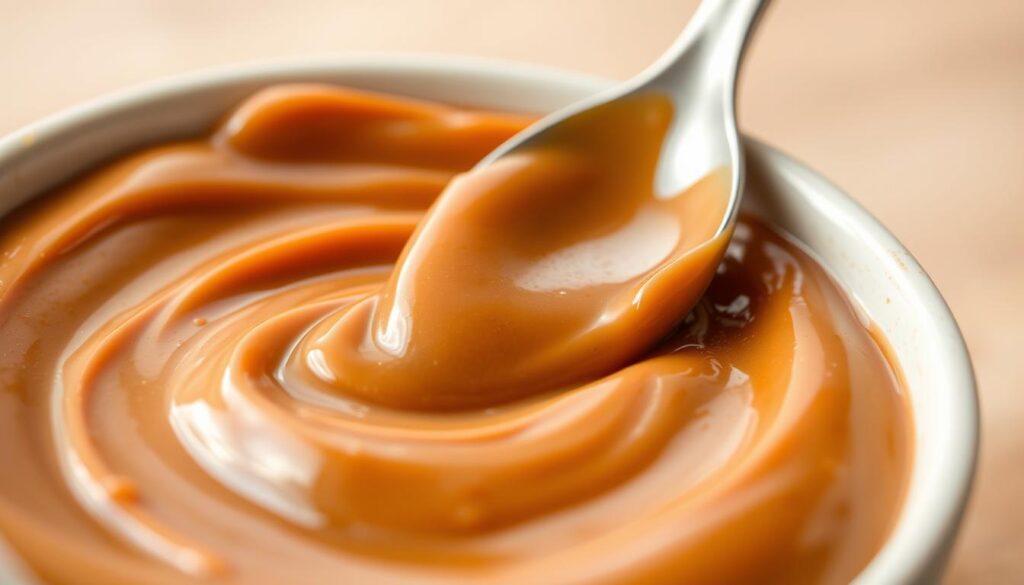
Sweetness: The Perfect Balance
The ideal kaya strikes a harmonious balance between sweetness and richness. Too much sugar can overpower the delicate pandan and coconut flavors, while too little leaves it bland. Brands like Glory and Fairprice excel in achieving this balance, making them popular choices.
Texture: Smooth and Creamy
A smooth, creamy texture is essential for a satisfying spread. It should glide effortlessly onto toast without being overly thick or runny. Premium options like Violet Oon deliver a velvety consistency, while budget-friendly picks like Heavenly Wang maintain a pleasing texture.
Fragrance: Pandan and Coconut Notes
The aroma of pandan and coconut is what makes kaya truly special. These fragrant notes should be prominent but not overwhelming. Brands like Ya Kun and Killiney Kopitiam are known for their authentic, aromatic spreads that capture the essence of traditional recipes.
Value: Affordable and Accessible
Great kaya doesn’t have to break the bank. Supermarkets like NTUC and Cold Storage offer affordable options, with Fairprice providing 410g for just $3.30. Specialty stores, on the other hand, cater to those seeking premium experiences, like Violet Oon’s $13.50 jar.
- Budget Heroes: Glory ($3.70/400g) offers excellent value, while premium brands like Violet Oon cater to gourmet tastes.
- Availability: Supermarkets like NTUC and Cold Storage stock widely accessible brands, while kopitiam-exclusive options offer unique flavors.
Whether you’re looking for an everyday spread or a luxurious treat, there’s a kaya option to suit every taste and budget. The key is finding the right balance of sweetness, texture, and fragrance that appeals to you.
Top 10 Best Kaya in Singapore
Exploring the top spots for kaya reveals a mix of tradition and innovation. From classic Hainanese recipes to modern artisanal creations, these brands and eateries offer something for every palate. Let’s dive into the ultimate list of must-try kaya spreads.

10. Chin Mee Chin: A Traditional Hainanese Classic
Chin Mee Chin brings back the nostalgia of old-school kopitiams. Their Hainanese-style kaya is rich, eggy, and perfectly balanced. Paired with their freshly baked buns, it’s a breakfast experience that feels like a trip back in time.
9. Tong Heng Traditional Cantonese Pastries: Nyonya Kaya with a Twist
Tong Heng offers a unique Nyonya-style kaya that’s slightly sweeter and infused with pandan. Their version is a delightful twist on the classic, making it a favorite among those who enjoy bold flavors.
8. Violet Oon: Artisanal Kaya with a Peranakan Touch
Violet Oon’s artisanal kaya is a gourmet treat. With a Peranakan influence, it boasts a rich, velvety texture and a fragrant pandan aroma. Perfect for those seeking a premium experience.
7. BreadTalk: Affordable and Consistent
BreadTalk offers a reliable and budget-friendly kaya spread. Its smooth texture and balanced sweetness make it a great choice for everyday use. Plus, it’s widely available across their outlets.
6. Kaya House: A Budget-Friendly Option
Kaya House delivers quality at an affordable price. Their spread is creamy, fragrant, and versatile, making it a hit for both toast and buns. A great option for families and kaya enthusiasts alike.
5. Killiney Kopitiam: Rich and Eggy
Killiney Kopitiam’s kaya is known for its rich, eggy flavor. The spread is smooth and pairs perfectly with their signature toast. A must-try for fans of traditional recipes.
4. Ya Kun Kaya Toast: Singapore’s Most Popular
Ya Kun is synonymous with kaya toast in Singapore. Their secret recipe, combined with charcoal-grilled bread, creates an unforgettable experience. A true icon in the world of kaya.
3. Glory: A Household Favorite
Glory’s kaya is a staple in many homes. Its creamy texture and balanced sweetness make it a versatile choice. Whether on toast or straight from the jar, it’s always a delight.
2. Fairprice: The Best Value for Money
Fairprice offers an excellent kaya spread at an unbeatable price. Its smooth consistency and authentic flavor make it a top pick for those looking for quality on a budget.
1. Heavenly Wang: The Ultimate Kaya Experience
Heavenly Wang takes the crown with its exceptional kaya spread. Priced at $4.20 for a 270g jar, it scored 90% for its caramel richness and vanilla aroma. The texture is creamy, and the fragrance is perfectly balanced. Halal-certified and available across 28 outlets, it’s versatile for toast, buns, or direct consumption. Truly the ultimate kaya experience.
- Champion for texture (creamy) and fragrance balance.
- Versatile for toast, buns, or direct consumption.
- Halal-certified accessibility across 28 outlets.
Exploring Different Types of Kaya
The world of kaya is as diverse as it is delicious, offering a range of flavors and styles to explore. From classic recipes to modern twists, each type brings its own unique charm. Let’s dive into the differences that make each version special.
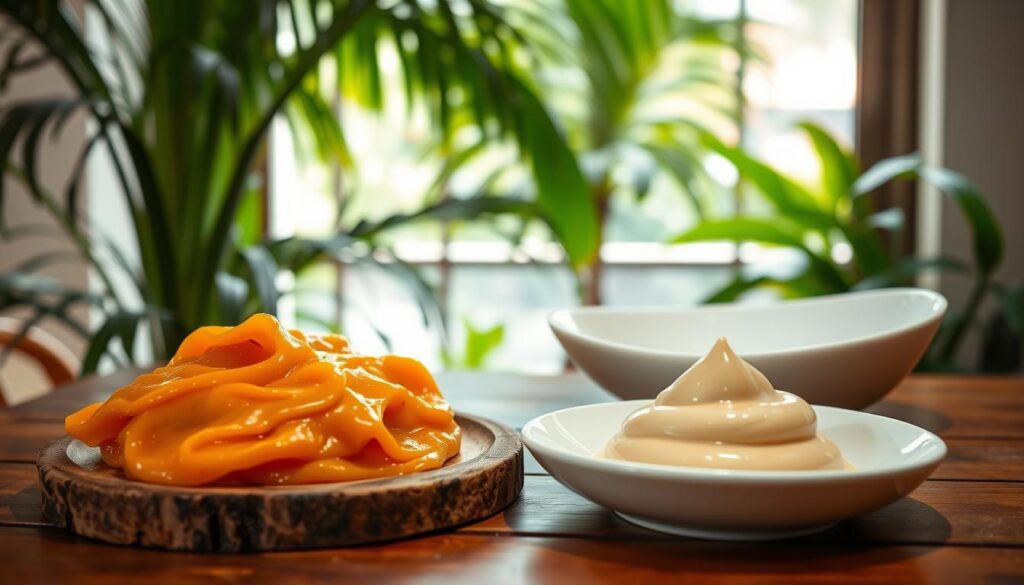
Hainanese Kaya vs. Nyonya Kaya
Hainanese kaya is known for its rich, eggy flavor and smooth texture. It’s a staple in traditional kopitiams, often paired with charcoal-grilled toast. Nyonya kaya, on the other hand, leans slightly sweeter with a stronger pandan aroma, reflecting its Peranakan roots.
While Hainanese kaya sticks to simplicity, Nyonya kaya often incorporates additional ingredients like gula melaka for a deeper flavor profile. Both are beloved, but the choice depends on your preference for richness or sweetness.
Traditional vs. Modern Kaya Recipes
Traditional recipes focus on time-tested methods, like slow-cooking over charcoal for a smoky finish. Modern takes, however, experiment with techniques like sous-vide eggs or pairing kaya with unexpected ingredients like foie gras.
For example, Micro Bakery offers a sourdough kaya toast for $7, blending artisanal bread with classic flavors. Meanwhile, SPAGO’s foie gras-kaya fusion showcases how this spread can elevate gourmet dishes.
“Kaya’s versatility allows it to shine in both traditional and contemporary settings.”
Gourmet innovations have also introduced kaya croissants and even cocktail infusions, proving that this spread is far from one-dimensional. Whether you prefer the comforting taste of tradition or the excitement of modern creativity, there’s a kaya style for everyone.
When it comes to shelf life, artisanal options often skip preservatives, offering a fresher taste but shorter storage time. Commercial jars, however, are designed for longevity, making them a practical choice for everyday use.
- Cooking Methods: Charcoal grills vs. sous-vide eggs.
- Gourmet Innovations: Kaya croissants and cocktail infusions.
- Shelf Life: Preservative-free artisanal vs. commercial jars.
Where to Enjoy the Best Kaya Toast in Singapore
For many, a day in Singapore starts with a slice of kaya toast. This iconic dish is a morning ritual that brings comfort and joy. Whether you prefer traditional kopitiams or modern cafes, there are plenty of spots to savor this classic treat.
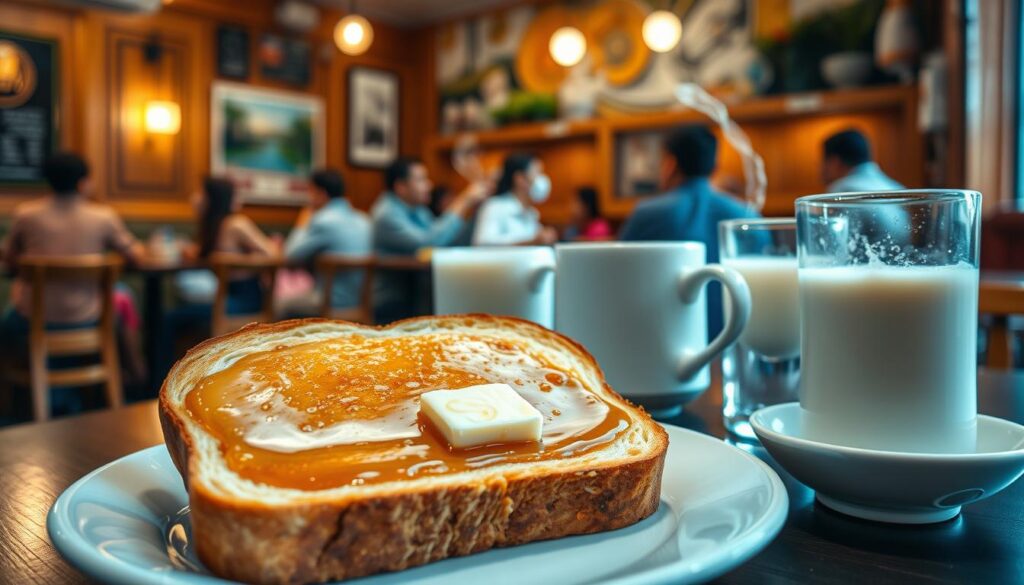
Ya Kun Kaya Toast: A Timeless Classic
Ya Kun Kaya Toast is a household name, known for its secret recipe and charcoal-grilled bread. The spread is smooth, fragrant, and perfectly balanced. Pair it with soft-boiled eggs and a cup of kopi for an authentic experience.
Toast Box: Fluffy and Thick
Toast Box offers a modern twist on the classic. Their toast is fluffy and thick, making it a favorite among locals. The kaya spread is creamy and pairs well with their signature drinks. It’s a great spot for a quick breakfast or a leisurely brunch.
Killiney Kopitiam: Eggy and Flavorful
Killiney Kopitiam is another must-visit for kaya enthusiasts. Their spread is rich and eggy, with a texture that’s both smooth and indulgent. The French loaf kaya toast, with its charcoal-grilled crusts and chunky kaya, is a standout dish.
- Must-try: Kaya French Toast with extra egg dip.
- Limited jar availability (check Fortune Centre).
- Stronger flavor profile suits adventurous palates.
| Spot | Specialty | Must-Try Item |
|---|---|---|
| Ya Kun Kaya Toast | Charcoal-grilled bread | Classic kaya toast set |
| Toast Box | Fluffy and thick toast | Kaya butter toast |
| Killiney Kopitiam | Eggy and flavorful spread | French loaf kaya toast |
How to Pair Kaya Toast with Other Breakfast Items
Pairing kaya toast with the right accompaniments can elevate your breakfast experience. The creamy, fragrant spread shines when combined with complementary flavors and textures. Let’s explore the perfect pairings that make this dish a morning favorite.
Soft-Boiled Eggs: The Perfect Companion
Soft-boiled eggs are a classic pairing for kaya toast. The silky texture of the eggs contrasts beautifully with the crispy toast, while the richness balances the sweetness of the spread. To enjoy, dip your toast into the runny yolk for a delightful combination of flavors.
This pairing is a staple in traditional kopitiams, where it’s often served as a set. The simplicity of soft-boiled eggs allows the kaya’s pandan and coconut notes to take center stage.
Kopi and Teh: Traditional Drinks to Complement Kaya
No kaya toast experience is complete without a cup of kopi or teh. These traditional drinks enhance the flavors of the spread, creating a harmonious breakfast ritual. Heap Seng Leong’s Kopi Gu You, a butter coffee, is a standout choice that amplifies kaya’s sweetness.
Here’s a quick guide to coffee and tea options:
- Kopi-O: Black coffee with sugar, perfect for those who prefer a strong, bold flavor.
- Kopi-C: Coffee with evaporated milk, offering a creamy texture.
- Yuan Yang: A mix of coffee and tea, ideal for those who enjoy a balanced taste.
For tea lovers, teh tarik is a frothy, pulled tea that contrasts beautifully with the crispy toast. Opt for “less sweet” versions to balance the kaya’s richness.
“The right drink can transform a simple kaya toast into a memorable breakfast.”
Whether you’re a fan of traditional pairings or enjoy experimenting with modern twists, these combinations will make your morning meal truly special. For more inspiration, check out this guide to the best kaya toast.
Underrated Kaya Toast Spots in Singapore
Beyond the well-known spots, Singapore hides some lesser-known gems for kaya toast lovers. These underrated locations offer unique flavors and experiences that deserve a spot on your breakfast itinerary. Let’s uncover these hidden treasures.
YY Kafei Dian: A Hidden Gem
YY Kafei Dian is a quaint spot that has been serving delicious kaya toast for decades. Known for its traditional recipes and cozy atmosphere, it’s a favorite among locals who appreciate authenticity. Their toast is crispy, and the kaya spread is rich with pandan aroma.
What sets this place apart is its commitment to preserving old-school flavors. Pair your toast with a cup of kopi for a nostalgic breakfast experience. It’s a must-visit for those who love the charm of traditional kopitiams.
Homeground Coffee Roasters: A Modern Take
Homeground Coffee Roasters offers a fresh twist on the classic kaya toast. Their version combines artisanal bread with a smooth, fragrant spread. The modern setting and innovative approach make it a standout choice for younger crowds.
Here, you’ll find a blend of tradition and creativity. Their kaya toast is perfect for those who enjoy a contemporary take on a beloved classic. Don’t forget to try their specialty coffee for a complete experience.
Ah Seng (Hai Nam) Coffee: Charcoal-Grilled Goodness
Ah Seng (Hai Nam) Coffee is a family-run stall at Maxwell Food Centre, known for its charcoal-grilled toast. Established in the 1950s, this spot has been a staple for generations. Their green kaya spread is a unique twist that’s both creamy and aromatic.
Must-try: Their french toast with a double portion of kaya, dipped in egg for extra richness. Be sure to visit early, as they close by 2pm. It’s a true hidden gem for those who appreciate traditional flavors with a touch of innovation.
Creative Kaya Toast Variations
Kaya toast isn’t just a breakfast item—it’s a canvas for creativity. From artisanal bakeries to home kitchens, chefs are reimagining this classic dish with unique twists. Whether you’re a fan of sweet and savory combinations or prefer a modern take, there’s a variation to suit every palate.
Kaya French Toast: A Sweet and Savory Delight
Kaya French toast combines the richness of custard-soaked bread with the fragrant sweetness of kaya. The result is a dish that’s both indulgent and satisfying. Dip it in soft-boiled eggs for a creamy contrast, or drizzle with honey for extra sweetness.
This variation is perfect for those who enjoy a balance of flavors. The crispy exterior and soft interior create a delightful texture that’s hard to resist. It’s a breakfast treat that feels both familiar and new.
Kaya Butter Buns: Soft and Fluffy
Kaya butter buns are a crowd-pleaser, offering a soft and fluffy base for the creamy spread. The combination of buttery richness and pandan aroma makes this a comforting choice. It’s ideal for those who prefer a lighter, less crispy option.
These buns are often served warm, allowing the kaya to melt slightly for an extra layer of flavor. Pair them with a cup of kopi for a complete breakfast experience.
Kaya with Sourdough: A Modern Twist
For a modern take, try kaya with sourdough bread. The tangy notes of the sourdough complement the sweetness of the spread, creating a unique flavor synergy. Micro Bakery’s version, priced at $7, is a standout with its sea salt garnish.
This variation is perfect for those who enjoy artisanal bread. The hearty texture of sourdough adds depth to the dish, making it a gourmet treat. It’s a great example of how traditional flavors can be elevated with a creative twist.
“Kaya toast is more than a dish—it’s an opportunity to explore new flavors and textures.”
Whether you’re a fan of classic recipes or enjoy experimenting with new ideas, these creative variations offer something for everyone. From French toast to sourdough, each version brings its own unique charm to the table.
Conclusion: Finding the Best Kaya in Singapore
Discovering the perfect spread for your morning meal can be a delightful journey. For a premium experience, Heavenly Wang stands out with its rich, creamy texture and balanced sweetness. If you’re on a budget, Fairprice offers excellent value without compromising on quality.
While Ya Kun and Killiney are iconic, don’t hesitate to explore lesser-known spots. Each place brings its own unique twist to this beloved dish. Personal preference plays a big role—some enjoy a sweeter spread, while others prefer a richer, eggy flavor.
Try both Hainanese and Nyonya varieties to fully appreciate the diversity of this classic treat. For those with dietary needs, always check halal certifications to ensure inclusivity. Whether it’s a quick bite or a leisurely meal, kaya toast remains a staple in Singapore’s vibrant breakfast culture.

